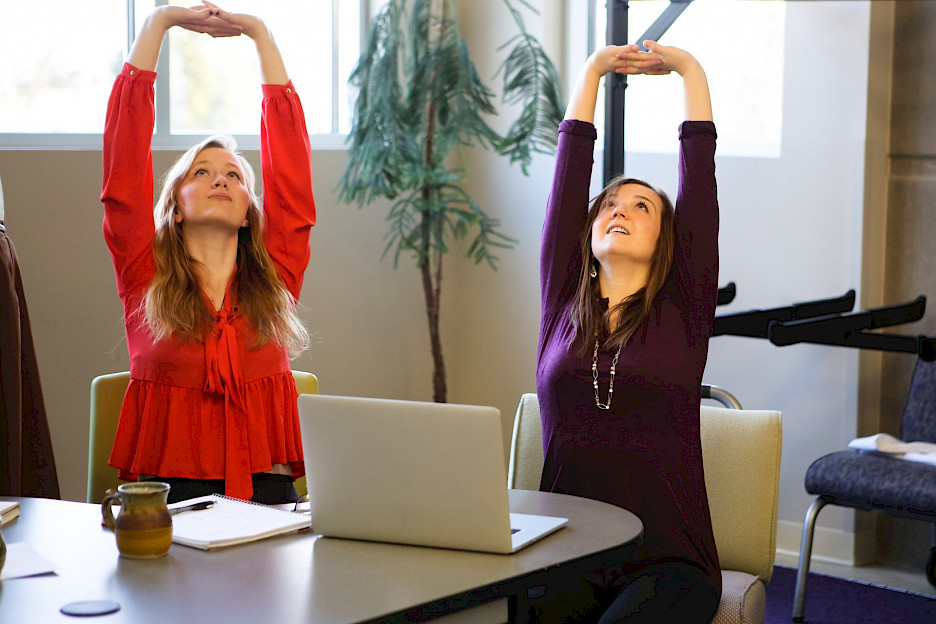Tried and tested ways to reduce sitting in lectures
What are the best practices that universities have put in place to take breaks and reduce sitting? Niko Peltokangas, OLL’s Head of Communications, found some good tips from his own studies.
In September I was preparing an introduction for a debate that was organised as part of the Time for a break?! campaign and trying to find examples of how to reduce sitting during lectures. I was pleased to realise that I have come across some good approaches in my own studies at a Finnish university.
Here are three ways to take breaks from sitting during a traditional 90-minute lecture:
- Language studies and exercise breaks: In a Latin lesson we were learning numbers during a teacher-led exercise break.
- Stretching one’s legs to note attendance: In one series of lectures, the teacher gave us a break halfway through and asked everyone to come to the front of the lecture hall and sign the attendance sheet.
- Permission to move: On the first slide of their lecture, a guest lecturer had added encouragement to freely take breaks from sitting at any point during the lecture.
Taking breaks means breaking norms
What do these simple real-life examples reveal about reduced sitting? I found six key factors.
I am pretty sure that there is some kind of training behind each approach. In the last few years, teachers have received training in different kinds of projects, and they have been offered material to help them take breaks from sitting.
Each example has required planning in advance. That requires the teacher to have the necessary resources: time, skills and knowledge about how to take breaks from sitting. They have also had to take the physical conditions of the lecture into consideration. Taking breaks looks different in lecture theatres with long rows of benches compared to rooms with adjustable desks and exercise balls.
The most difficult demands are emotional ones. Leading exercise breaks means overcoming shame and having the nerve. Reducing sitting is all about breaking norms, because traditionally people have done whatever they can to be comfortable – i.e. avoid physical exertion.
The examples also highlight how important it is for the teacher to find a way to take breaks that suits them. Ideally students would also eventually find their own ways to look after their ability to study and work.

What can students do?
Research shows that students expect the university and the teachers to provide instructions and opportunities to reduce sitting. Naturally more active students will demand breaks directly, both during lectures and in working groups and university bodies with student representatives.
Direct feedback also plays a part. As I was trying to remember my experiences of taking breaks from sitting during lectures, I also had a look at my university inbox. There I came across an email I’d sent to my Latin teacher after the first module with a suggestion to add a break into the lecture template.
I haven’t yet dared suggest a break in the middle of a lecture, but it seems to have worked via email too. It was great to see that the teacher had taken my suggestion on board and also found a natural way to include exercise breaks in their teaching.

You may also be interested in
-
"The Time for a break?" campaign encourages university students and teachers to reduce sitting
Published:This year, the Finnish Student Sports Federation OLL’s annual #BeActive weeks 22.9–3.10 aim to get people to pay attention to taking breaks from sitting while studying. Moving your body while studying improves the ability to study, but students still sit 10.5 hours per day.
-
4 exercising tips for the new academic year for students
Published:Physical activity has been proven to improve study ability. In addition to sweaty training sessions, everyday exercise and taking breaks from sitting are an important part of an active student lifestyle. Explore the Student Sports Federation’s (OLL) exercise tips for the new academic year!
Read more about article: 4 exercising tips for the new academic year for students
-
The Finnish Student Sports Federation invites students to test their exercise habits and study ability
Published:The Finnish Student Sports Federation (OLL) is reminding people in September and October of the importance exercise in maintaining and improving study ability.
Share this page
Page last updated 23.10.2025
